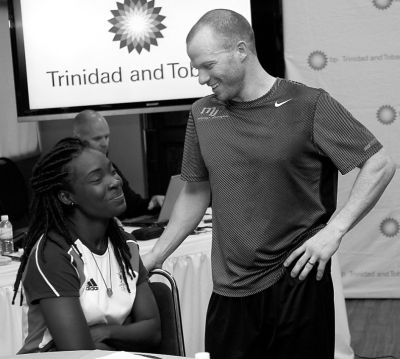media_artricles :: 2013
MJP’s approach right for athlete development
Asha De Freitas-Moseley :: Trinidad Guardian :: 05.11.2013As a sports and exercise professional in Trinidad, it can be very easy to feel a little out of touch with what is happening in the industry in the international arena simply because so many things are so behind what is being done in developed countries. It can seem a bit like a time warp but what helps to counter that feeling is continuing education courses, exposing you to the latest training techniques and/or visiting leading facilities or talking with leading professionals in the industry. This usually helps me to feel re-energised in my trade.
Two weeks ago, when I attended the Michael Johnson Performance (MJP) workshop that was hosted by BPTT and the TTOC, I was like a kid in a candy store. Every moment of each of the three days, I came in ready to learn everything they had to offer. The ethos of MJP parallels mine in so many ways that listening and learning from them was easy. I hear Trinidadians often label Americans as over-confident to the point of cocky, but coaches like these counter this label as they were most humble and willing to share their knowledge. I used the word “share” as they spent a lot of their time with coaches during the breaks and at the end of each day, engaging in dialogue with the attendees which comprised largely of coaches in different sports.
Lance Walker is a strength and conditioning specialist as well as a physiotherapist. Brian Abardie, his right-hand man is also a strength and conditioning specialist. Both their portfolios are decorated with experience training athletes from youth development level all the way to the professional level. While they enjoy all levels of their exposure because each level requires a different emphasis in training structure, they are particularly passionate about the youth development level. I was thrilled when I realised this as youth development is where a great need for attention and development exists, locally.
MJP’s involvement has the potential to be very helpful in moving T&T towards producing healthier, more competitive athletes at all levels of the spectrum. Its success lies with those attending and their ability to evolve their programs in areas where they recognise there is room for improvement. This is usually where things get lost—moving it from the note books to the training grounds; spending time understanding why the adjustment is needed and fitting it into compliment the current structure. Lance and Brian always said that the solution is likely not to throw out what is currently being done, but to evolve it to make it better. Their hope was that their workshop could be a part of that, however small or significant.
With reference to the age specific phase biases of coaching MJP revealed the objective of training for the specific age categories—what is important at early primary school level versus later primary school level and likewise for earlier versus later secondary school level and above. It is the applications of these systems, working at high volumes as their market allows, combined with their hunger to perfect the formula for age-appropriate training that provides these professionals with a plethora of knowledge. They admitted that in order to stay current with coaching techniques, they cannot wait for science as this will place them 10 years behind. Rather, they must be able to recognise the trends within the facility and within the industry and be able to assess and analyse them. Hence, at the highest levels this industry is a mixture of art and science. Experience helps with finding that critical balance.
MJP has a very well-rounded approach to athlete development; a fact conveyed in the stats that they keep on their teams. While they can tell you how many pros they have produced, they can also relay their stats on injury rates, days missed from practice due to injury, frequency rate of particular types of injuries… and this is how things are done in a top-rate facility to know how best to structure their programmes and convey whether they are doing a good job of it. Just one of the benefits of being aligned full-time to a team.
I commend BPTT and TTOC for their commitment to sport development on a long-term scale. There should be no doubt in the minds of these two parties that the rewards of these investments will not come in the next year or two. The real reward, if we can stay the course will meet us in the next 10 years, when I am in my 40s and our pre-adolescents and adolescents are young adults of whom the expectations would be vastly different to hopefully match the exposure they have been afforded. If we can all stay committed, both the public and private sectors from coach to sponsor.
Asha De Freitas-Moseley is a certified athletic trainer with the National Athletic Trainers’ Association of the USA. She has over 10 years of experience rehabilitating athletes and members of the active population from injury to full play. She can be reached at Pulse Performance Ltd., located at #17 Henry Pierre Street, St James. Tel: 221-2437.

Enlarge Image
Certified strength and conditioning specialist Brian Abadie chats with Royalians rugby coach Kwanieze John at the MJP programme three-day workshop at the Hasely Crawford Stadium in Mucurapo, last week. PHOTO: ABRAHAM DIAZ

Close Window